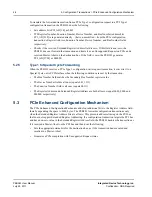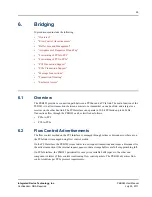
6. Bridging > Buffer Size and Management
50
PEB383 User Manual
July 25, 2011
Integrated Device Technology, Inc.
Confidential - NDA Required
6.3
Buffer Size and Management
The PEB383 provides sufficient buffering to satisfy PCIe bridging requirements. The PEB383 does not
overcommit its buffers: it forwards requests onto the other side only when enough buffer space is
reserved to handle the returned completions.
The PEB383 uses 1-KB retry buffering, which is large enough to ensure that under normal operating
conditions upstream traffic is never throttled. Ack latency value, internal processing delays, and
receiver L0s exit latency values, are considered for determining the Retry buffer size.
6.4
Assignment of Requestor ID and Tag
The PEB383 assigns a unique transaction ID for all the non-posted requests forwarded to upstream
devices. The PEB383 takes ownership of the upstream transactions on behalf of original requestors,
and stores the transaction-related state information needed to return the completions to the original
requesters. The action of replacing the original transaction’s requester ID and/or Tag fields with the
bridge’s own assigned values is referred to as taking ownership of the transaction.
For upstream non-posted requests, the PEB383 assigns the PCIe requester ID using its secondary bus
number and sets both the device number and function number fields to zero. For the upstream
transactions, the PEB383 sets the Tag field to a request enqueued entry number.
6.5
Forwarding of PCIe to PCI
The PEB383 forwards posted, non-posted, and upstream read completions to the PCI devices, and
stores the non-posted TLPs’ state information to return the completion TLPs to the PCIe Interface.
6.5.1
PCIe Memory Write Request
The PEB383 forwards the received PCIe Memory Write Requests to the PCI Interface with either
Memory Write (MW) or Memory Write and Invalidate (MWI) command. The PEB383 translates the
request into a PCI transaction using the MWI command if it meets the MWI command rules specified
in the
PCI Local Bus Specification (Revision 3.0)
, and the MWI bit is set in the
. An MW command is used for the remaining part of the MWI transaction if the transaction is
disconnected such that the remaining request does not meet the MWI command rules. The PEB383
does not support relaxed ordering among the received requests. It forwards all requests in the order
they are received even if the relaxed ordering bit is set for some of the requests.
6.5.2
PCIe Non-posted Requests
The PEB383 translates the PCIe Memory Read Requests into PCI transactions that use a PCI memory
read command (that is, Memory Read, Memory Read Line, or Memory Read Multiple) based on its
cacheline size value, requested byte enables, and prefetchable and non-prefetchable memory windows.
PCIe Read Request command translation is completed as follows:
•
Memory Read if the PCIe Request falls into the non-prefetchable address range defined by the
















































